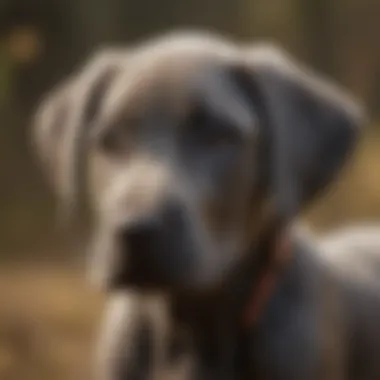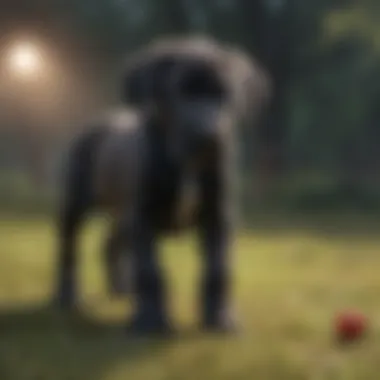Understanding Great Dane Puppy Characteristics


Intro
The Great Dane is a breed that often leaves a strong impression due to its sheer size and gentle demeanor. Understanding the characteristics of Great Dane puppies requires a nuanced examination of their unique attributes. This section will set the stage for a deeper exploration of their traits, focusing on various aspects of their growth and behavior. Thus, potential owners can appreciate the wonderful balance between their imposing presence and gentle spirit.
Animal Overview
Common Name and Scientific Classification
The Great Dane, known scientifically as Canis lupus familiaris, is a prominent breed recognized for its towering height and graceful build. Often referred to as the "gentle giant," this breed finds its place in many homes across the world. Their classification as a domestic dog brings them into a distinct space among popular canine breeds.
Physical Characteristics
Great Danes are notable for their impressive physical stature. Adult Danes often weigh between 110 to 175 pounds, with some exceptionally large individuals exceeding this range. Their height typically falls within 28 to 34 inches at the shoulder. With a muscular body, a long neck, and a broad head, they exude a regal presence. Their coat can vary in color and pattern, including fawn, brindle, blue, black, harlequin, and mantle. Despite their size, Great Dane puppies often retain an exceptionally playful and affectionate nature.
Habitat and Distribution
The Great Dane is a breed that thrives in domestic environments, particularly in family homes. While not confined to geographical boundaries like some wildlife species, the distribution of Great Danes is global, with a strong presence in countries such as the United States, Germany, and the United Kingdom. These dogs adapt well to various living conditions, though they require ample space to accommodate their large size.
Behavior and Social Structure
Communication Methods
Great Danes are excellent communicators. They express themselves through various vocalizations, including barking, growling, and whining. These methods serve distinct purposes, such as indicating excitement or alerting their owners to potential threats. Additionally, body language plays a pivotal role in their communication. Positioning of ears, wagging tails, and posture can convey significant information about their mood and intentions.
Social Hierarchies
In a household, Great Danes form strong bonds with their human counterparts. They often see themselves as part of the family unit, developing a natural desire to protect and engage with their owners. Establishing leadership in a gentle and consistent manner is essential. With proper training, they recognize their place within the social structure, leading to well-adjusted behavior.
Mating and Reproductive Behavior
Understanding the reproductive aspects of Great Danes is essential for responsible breeding. Female Danes typically come into heat twice a year. Mating often requires careful monitoring due to their size and potential health risks. It is crucial for owners to seek veterinary guidance to ensure the health of both the mother and her puppies.
Conservation Status
Current Population Trends
While the Great Dane is not considered endangered, conscientious breeding practices help maintain population health. Awareness of potential genetic health issues is crucial as they may affect the breed's overall vitality.
Threats and Challenges
Great Danes face specific challenges regarding health due to their size. Common concerns include hip dysplasia, bloat, and other orthopedic issues. Furthermore, awareness about responsible ownership plays a fundamental role in addressing challenges often faced by large breeds.
Conservation Efforts and Success Stories
Many breed clubs and organizations are actively involved in the conservation of Great Danes. These bodies offer education on responsible breeding and health screening practices. Encouraging participation in community events raises awareness and promotes a healthy future for the breed.
Foreword to Great Danes
Great Danes, often referred to as the "gentle giants" of the dog world, possess a unique blend of characteristics that make them a captivating breed. Understanding these traits is essential not only for prospective owners but also for those looking to appreciate the intricacies of canine behavior and physiology. This section lays a foundation for the broader discussion on Great Dane puppies, setting the stage for deeper exploration into their historical roots and breed recognition.
Importance of Understanding Great Danes
The Great Dane is more than just a large dog; its attributes define a legacy of companionship and loyalty. Awareness of their unique needs fosters a well-prepared environment, ensuring both the pet and owner have a fulfilling life together. Key benefits include:
- Compatibility: Identifying one's lifestyle with a Great Dane’s requirements can help in making informed decisions about adoption.
- Preparation: Knowledge of historical context informs training strategies and behavioral expectations.
- Recognition: Understanding breed specifics aids in navigating veterinary care and potential health issues.
Historical Background


The historical journey of the Great Dane reveals much about its nature today. Initially bred for hunting large game, they were more robust and had a different appearance than modern counterparts. Their lineage can be traced back to the ancient Mastiffs of Europe, where they were revered for their strength and courage.
In the 18th century, Great Danes became popular as noble companions in the courts of Europe. Known for their stature and grace, they represented both power and elegance. The breed quickly became recognized for its gentle demeanor, which juxtaposed their imposing size.
"The Great Dane's transition from a fierce hunter to a beloved family member illustrates its adaptability and deep bond with humans."
Breed Recognition
Breed recognition plays an integral role in understanding Great Danes. Various kennel clubs and organizations establish guidelines that define breed standards.
In the United States, the American Kennel Club (AKC) recognizes the Great Dane as a member of the Working Group. They highlight qualities such as:
- Size: An average adult male can weigh between 140 to 175 pounds.
- Temperament: Typically gentle and friendly, Great Danes thrive in social environments.
- Appearance: A distinctive height; many stand over 30 inches at the shoulder when fully grown.
Similar recognition is found globally, with clubs in countries such as the United Kingdom and Australia valuing the breed for its unique attributes. Understanding breed standards aids in recognizing well-bred puppies, guiding potential owners in adoption choices.
Physical Characteristics of Great Dane Puppies
Understanding the physical characteristics of Great Dane puppies is essential for prospective owners. These attributes offer insight into their care requirements and living arrangements. The appearance of a Great Dane can influence the dynamics of family life. Their size, weight, and distinctive features play a crucial role in their interaction with humans and other pets. Moreover, familiarizing oneself with these traits allows owners to anticipate potential health concerns and grooming needs. All these elements combine to create a comprehensive picture of what it means to care for a Great Dane puppy.
Size and Weight
Great Dane puppies are known for their impressive size and weight, even when they are young. Generally, at just a few months old, they can weigh between 30 to 50 pounds. Their growth rate is significant, and they can reach adult sizes of around 100 to 175 pounds. This rapid growth necessitates a careful approach to training and nutrition. Large breeds like Great Danes are prone to specific health issues, such as hip dysplasia, that can be influenced by their size. Therefore, monitoring their growth is paramount. Proper diet and exercise play critical roles in ensuring that these puppies develop healthy musculature and maintain a balanced weight.
Coat Types and Colors
The coat types and colors of Great Dane puppies vary widely, contributing to their unique appearance. They typically have a short, smooth coat that is easy to maintain. Common colors include fawn, brindle, blue, black, and harlequin. Each color comes with its charm, and owners often choose based on personal preference. The coat also provides insight into their health; a glossy and well-kept coat can indicate good nutrition and care. However, some colors might be more susceptible to sunburn, especially lighter shades. Therefore, considering your living environment and climate can influence your care regimen.
Distinctive Features
Distinctive features are what set Great Danes apart from other breeds. Their large frames are accentuated by unique characteristics, making them easily recognizable. Understanding these distinctive traits is essential for potential owners.
Eye Shape and Color
The eye shape and color of Great Dane puppies often capture attention. They usually have large, expressive eyes that can be in shades of amber, blue, or dark brown. The soulful expression associated with these puppies creates a strong bond with families. Their eye shape is somewhat oval, contributing to their alertness and curiosity. This attribute can be a beneficial choice for families, as it reflects the personality of the dog and enhances its emotional connection with humans. However, certain eye conditions, such as cataracts, can occur, so regular veterinarian check-ups are recommended.
Ear Structure
Great Danes can have ears that are either cropped or left natural. Cropped ears stand erect, giving the dog a regal appearance. However, this practice is controversial. Natural ears are floppy, adding to their distinct charm while also being more comfortable for the dog. The ear structure influences their hearing capabilities as well. Floppy ears can protect their hearing from environmental factors, yet they may require more regular cleaning to prevent infections. Understanding the ear structure is key, as it can affect overall wellbeing and grooming needs.
Tail Characteristics
The tail characteristics of Great Danes are another defining feature. They have long, powerful tails that can be quite expressive. The tail is usually carried high when the dog is happy, and this can be a helpful indicator of its mood. It is important to note that their tails can cause accidental injuries if not managed properly, especially in confined spaces. Tail wagging can create a significant force, so educating family members about maintaining a safe environment is essential for this breed. A well-cared tail gives a positive impression of good health and happiness in a Great Dane puppy.
Temperamental Traits
Understanding the temperament of Great Dane puppies is essential for both current and prospective dog owners. Their personality traits influence how they interact with their environment, other animals, and humans. Recognizing these traits helps in building a strong bond and allows families to provide a suitable living environment. Great Danes are known for their gentle and affectionate nature, which is foundational for a harmonious family life.
General Personality
Great Danes are often described as gentle giants. This breed possesses a unique combination of strength and sensitivity. They generally have a calm demeanor and are affectionate towards their families. Their playful nature makes them good companions, especially for children. However, it is important to weigh their size with their sensitive nature. Early socialization and training is crucial for their development.
Key traits of Great Dane personalities include:
- Affectionate: They tend to form deep emotional bonds with their owners.
- Playful: Their enthusiasm for play can last well into adulthood.
- Protective: They are instinctively protective over their loved ones, which can make them good watch dogs.
Social Behavior with Humans


Great Danes have a remarkable ability to connect with people. They enjoy human interaction and thrive on companionship. Their size might be intimidating to some, but they are actually gentle and sociable. They usually get along well with different ages, including children and the elderly. Training lessons that encourage positive behaviors, such as greetings and appropriate play, are beneficial.
"Great Danes might seem imposing at first glance, but their sociable nature enables them to integrate well into family life."
Being aware of their social tendencies helps foster better relationships within the family. They require consistent socialization from a young age to prevent any anxiety in new or unfamiliar scenarios.
Interactions with Other Pets
Great Danes can coexist peacefully with other pets. Their temperament is generally non-aggressive, often demonstrating a calm attitude towards smaller animals. However, supervision is recommended during initial introductions to ensure that all animals feel secure. It is essential to teach Great Danes the appropriate way to interact with pets of differing sizes. Basic commands, such as sit and stay, can help facilitate positive interactions.
- Supervised introductions: Always observe their early encounters.
- Positive reinforcement: Reward good behavior with treats or affection to encourage friendly interactions.
- Establish boundaries: Define personal space for smaller pets to ensure safety.
In summary, Great Danes are loving and sociable dogs. Understanding their temperamental traits helps owners establish a nurturing environment while promoting positive relationships with humans and other pets.
Health Considerations for Great Dane Puppies
Understanding health considerations for Great Dane puppies is crucial for prospective owners. This breed, known for its size, has specific health risks and needs. Recognizing these factors will help pet owners provide a better quality of life for their Great Danes. The right health care can prevent common issues, support a longer lifespan, and ensure that the puppy develops properly. This section delves into health problems that often affect Great Danes, the importance of routine veterinary care, and the dietary requirements necessary for their well-being.
Common Health Issues
Great Danes, while often healthy, are predisposed to certain health issues. Here are a few common concerns:
- Hip Dysplasia: A genetic condition where the hip joint fails to develop properly. It can lead to arthritis and discomfort.
- Bloat (Gastric Dilatation-Volvulus): A serious condition where the stomach fills with gas and twists. This happens suddenly and needs immediate attention.
- Cardiomyopathy: A heart condition affecting Great Danes more than many other breeds. Regular check-ups are essential for early detection.
- Osteosarcoma: Bone cancer is more prevalent in large breeds like Great Danes. Awareness of symptoms can lead to early treatment.
These conditions underline the importance of being proactive about a Great Dane's health right from puppyhood.
Importance of Regular Veterinary Care
Routine veterinary visits are essential for Great Danes. From vaccinations to health check-ups, these appointments help catch potential problems early. Here are some key aspects of why regular veterinary care is critical:
- Preventative Care: Regular vaccinations and parasite control can prevent serious diseases.
- Early Detection: Routine examinations can lead to early detection of issues like hip dysplasia or heart conditions, improving treatment outcomes.
- Weight Management: Great Danes are prone to obesity. Vets can provide guidance to keep their weight in check, which is vital for joint and overall health.
A relationship with a veterinarian ensures a Great Dane puppy grows up healthy and addresses any issues promptly.
Dietary Requirements
Diet plays a vital role in the health of Great Dane puppies. Understanding their needs helps prevent nutritional deficiencies or excesses. Key components include:
- High-Quality Protein: Great Danes require protein-rich diets to support their rapid growth. Look for dog foods specifically formulated for large breeds.
- Calcium and Phosphorus Balance: The ratio between these minerals is crucial to support proper bone development and prevent conditions such as osteochondrosis.
- Controlled Portions: Due to their inclination towards bloat, feeding smaller, more frequent meals helps minimize the risk.
- Hydration: Constant access to fresh water is essential for overall health.
Providing a balanced diet will contribute significantly to the growth and well-being of a Great Dane puppy, paving the way for a happy and healthy life.
"Understanding and managing health considerations in your Great Dane puppy can lead to a longer, happier relationship with your pet."
By focusing on these health considerations, owners can prepare to welcome Great Dane puppies into their homes with the necessary knowledge and resources to ensure long-term health and happiness.
Training Strategies for Great Dane Puppies
Training Great Dane puppies is essential. These dogs are known for their size and strength, and proper training ensures a harmonious relationship between them and their families. Great Danes can grow up to be imposing figures, and untrained behavior could lead to challenges, both in the household and in public settings. Training not only fosters good behavior but also strengthens the bond between the puppy and its owner. Effective training strategies will enhance the overall quality of life for the dog and the family.
Basic Obedience Training
Basic obedience training lays the foundation for all future learning. This training focuses on essential commands such as "sit", "stay", "come", and "down". These commands are pivotal in managing a Great Dane, especially due to their large size and unique behavior traits.
To begin, use positive reinforcement methods. Treats, praise, or playtime are excellent motivators for puppies. Start training sessions in a quiet environment to minimize distractions. Short sessions of 5-10 minutes are ideal, keeping the puppy engaged without overwhelming them. Consistency is key. Repeating commands and rewarding prompt responses will help the puppy learn faster.
Socialization Techniques


Socialization is a critical aspect of a Great Dane’s early development. Introducing the puppy to various environments, people, and other pets helps develop a well-adjusted adult dog. Begin socialization at a young age to enhance confidence in unfamiliar situations.
Take your puppy on walks in different places. Experiences in parks, stores, and around busy streets are beneficial. Enroll in puppy classes that allow interaction with peers. Use positive experiences to encourage friendly behavior. The goal is to ensure that the Great Dane does not become shy or aggressive due to a lack of social exposure.
Addressing Behavioral Issues
Addressing behavioral issues effectively is crucial for the well-being of the puppy and the family. Common problems include excessive barking, chewing, and jumping. Identifying the root cause of these behaviors is essential.
For instance, persistent barking might indicate boredom. Increasing physical exercise and mental stimulation through interactive toys can help alleviate this behavior. Additionally, redirecting chewing onto appropriate items is vital.
When addressing jumping, teach the puppy to sit when greeting people. This not only calms the situation but also promotes better manners.
Proper training ensures that Great Danes are happy, healthy, and well-adjusted members of their families.
Living Arrangements for Great Danes
Living arrangements are crucial for any dog, but particularly for a breed as large as the Great Dane. These dogs require special consideration in their living conditions to ensure not just comfort but also their overall well-being. Having the right space and supplies can make a significant difference in their mental and physical health.
Space Requirements
Great Danes are one of the largest dog breeds. Their sheer size necessitates significant living space. Ideally, a Great Dane should have access to a yard where it can exercise and stretch out. Space is not just about square footage, but also about the layout of the home.
In general, these dogs thrive in homes where they do not feel cramped. For families living in apartments, it is essential to have nearby parks or outdoor spaces to facilitate regular exercise. Without adequate space, they can become anxious or develop destructive behaviors. A spacious environment fosters a sense of security, allowing the dog to roam and find a comfortable place to rest.
Supplies Needed
When preparing for a Great Dane puppy, certain supplies are essential to create a nurturing environment. Key items include crates, beds, toys, and chew items. Each component plays its own role in supporting the dog's well-being and sense of security.
Crates and Beds
Crates serve multiple purposes for Great Danes. They provide a safe place for the puppy to retreat when feeling overwhelmed. A crate can promote house training and help with anxiety issues, as it offers a defined personal space.
Beds should be large and comfortable, accommodating their size while offering adequate support. Options include orthopedic beds, which can be beneficial for their joints as they age.
Great Dane-specific crates and beds often feature:
- Durability: These products must withstand significant wear and tear.
- Spaciousness: Large enough to allow the dog to lie down and turn comfortably.
- Easy to clean materials: Keeping the living area hygienic is important for a healthy dog.
Toys and Chews
Toys and chews are not just for entertainment; they also play a crucial role in the development and well-being of Great Danes. Engaging toys can help with mental stimulation and prevent boredom, thus reducing destructive behaviors.
When selecting toys, prioritize those that are tough and designed for larger breeds. Benefits of high-quality toys include:
- Durability: They should withstand vigorous chewing and play.
- Variety: Offering different types of toys can cater to various play styles, from interactive to solitary.
- Safety: Non-toxic materials are essential to prevent health issues during play.
In summary, the right living arrangements help ensure that Great Danes lead happy and healthy lives. By considering space requirements and providing necessary supplies, owners can create a harmonious environment that meets the unique needs of this remarkable breed.
Epilogue: Assessing the Commitment
The decision to bring a Great Dane puppy into one’s life is significant and requires careful consideration. This section aims to address the essence of committing to this breed, which boasts both unique attributes and distinct challenges. Assessing the commitment involves understanding the long-term obligations tied to caring for a large dog, ensuring that potential owners are not only informed but also prepared for the realities of life with a Great Dane.
Long-Term Responsibility
Owning a Great Dane carries an immense responsibility. These dogs, although known for their gentle nature, require consistent training and socialization. This means that owners must be committed to various training sessions throughout their puppy's life, shaping behaviors that will enhance the dog's reliability around family members and other pets. In addition to training, health maintenance is crucial. Regular veterinary visits are necessary to monitor the dog’s health, identify any potential genetic disorders, and manage weight appropriately, as Great Danes are prone to obesity.
Moreover, Great Danes typically live between 7 to 10 years. It is vital for prospective owners to be aware that this span requires dedication and love over many years. Consider how your life, work, and family dynamics may affect your ability to provide for these requirements.
Evaluating Lifestyle Compatibility
Lifestyle compatibility is another critical aspect of dog ownership that cannot be overlooked. Great Danes, despite their large stature, are known for their affectionate personalities. They often become integrated into the family structure. Therefore, it is essential to evaluate how a Great Dane puppy will fit into your daily life. Daily walks, playtime, and attention are paramount. Consider your home environment.
Do you have enough space for a large dog? An apartment may work with large breeds, but owning a house with a yard can greatly benefit a Great Dane's exercise needs. Also, think about family members—older children may better understand a Great Dane's needs and behaviors than very young ones.
Assessing your work schedule is equally important. Great Danes do not thrive when left alone for long periods. This breed seeks companionship, and separation anxiety can become an issue. Owners should ensure that they can dedicate substantial time for interaction and care. To sum it up, matching a Great Dane's needs with your lifestyle is crucial to ensure a harmonious and happy home.







